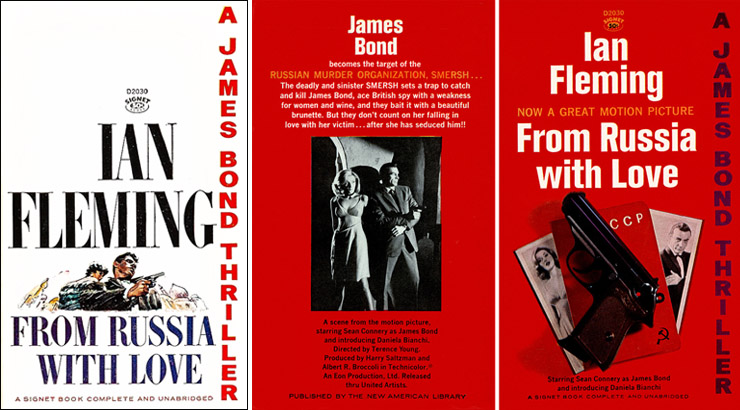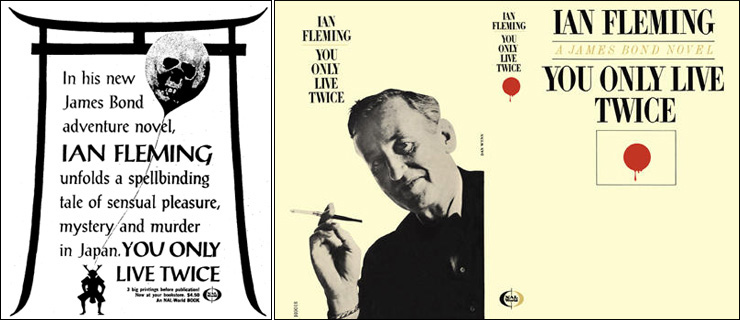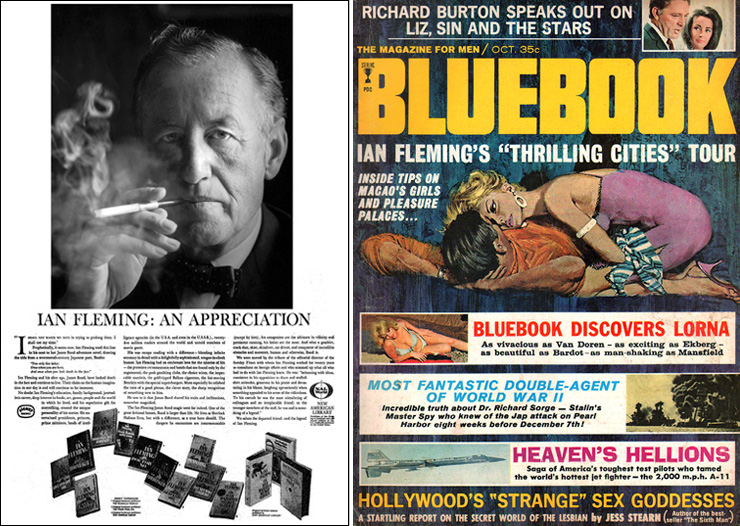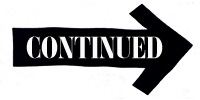|
|
JAMES BOND FACT FILES |
|
|
JAMES BOND FACT FILES |
|
||||||
 |
||||||
|
||||||
|
The dust jacket for the US New American Library hardback of ON HER MAJESTY'S SECRET SERVICE was devised by influential designer Paul Bacon (1923-2015), whose signature style was to use one simple graphic motif to capture the essence of a novel. For ON HER MAJESTY'S SECRET SERVICE it was a golden gryphon holding a gun, which was later re-used on the Signet paperback edition a year later. The typeface on the hardcover edition was also identical to the Signet paperback series, with a stylish portrait of Ian Fleming by American photographer Dan Wynn (1920-1995) on the rear cover, that was also used widely in advertising for the novel. The photograph was later used as the cover of the Signet paperback edition of OCTOPUSSY, and also appeared on the 1965 box set of Signet paperbacks The Complete Ian Fleming. In his 50-year career Paul Bacon designed around 6,500 book covers and 200 record sleeves, including the iconic dust jackets for the first edition hardbacks of Joseph Heller's Catch-22 (1961), Peter Benchley's Jaws (1974), and Marathon Man (1974) by William Goldman. |
||||||
|
||||||
|
Fleming's US publisher had asked him to revise the essay for its appearance in Thrilling Cities, but the author refused and the New American Library trimmed the New York chapter themselves. In mitigation, Fleming offered the brief 007 IN NEW YORK, which had already appeared in the New York Herald Tribune. The story featured the second appearance of the character name Solange (originally appearing in the short story FROM A VIEW TO A KILL, and later in the 2006 film version of Casino Royale), and the authors’ recipe for rich scrambled eggs. 007 IN NEW YORK would not be published in the UK until November 7, 1999, when it appeared in The Sunday Times Magazine James Bond supplement which sported a cover illustration by seven-time James Bond poster artist Robert McGinnis. 007 IN NEW YORK is now included in all paperback editions of OCTOPUSSY. |
||||||
|
|
||||||
|
The US hardback edition of Thrilling Cites had a glossy dust jacket by influential graphic designer Milton Glaser (1929-2020) featuring a battered suitcase covered in colourful stickers. Glaser also provided the clever illustrations at the start of each chapter depicting the thirteen cities featured in the omnibus. The US printing of Thrilling Cities did not include the photographs present in the 1963 Jonathan Cape UK hardcover edition. |
||||||
 |
||||||
|
With ON HER MAJESTY'S SECRET SERVICE on the best-seller list for six months, the novel received consistently excellent reviews in the US press, with only Anthony Boucher of the New York Times once again taking the opportunity to share his disapproval of Fleming's work on August 25, 1963 - a few weeks before the books' publication:
Other reviews were more generous, with the Washington Star declaring that “Ian Fleming's books are exciting the way a dream is exciting.” Victor Haas of the Omaha World-Herald also praised the novel further: “A literary romp of a superlative sort... Fleming is in a class by himself. His James Bond stories are among the best in the genre published in our time.” |
||||||
 |
||||||
|
With the success of Dr. No (1962) and the announcement that its follow-up From Russia With Love (1963) would debut in the USA in April of 1964, Signet issued a movie tie-in version of the novel which retained the same catalogue number (D2030) as the 1961 edition with the Barye Phillips vignette cover. YOU ONLY LIVE TWICE was published in hardback in the UK on March 16, 1964 although the details of Bond's ‘death’ had already been leaked by the UK newspaper the Daily Sketch on November 15, 1963. The tabloid newspaper ran an article entitled ‘In Memoriam James Bond’, and printed the obituary written by M from chapter 21 in full. Apparently the newspaper had obtained an early proof copy of the novel, and published the story accompanied by an illustration of Sean Connery's face. Coming just a week before his own appearance in the High Court, Ian Fleming was incensed by the Daily Sketch article feeling they had given away an important twist from his forthcoming novel, and was compelled to take legal action himself. An injunction was granted preventing the newspaper from revealing anything further from the story, but the damage was done and the author received many angry letters from readers unhappy that their hero was being ‘killed off’. Sir Arthur Conan Doyle (1859-1930) faced the same public reaction to his short story The Final Problem (1893), which ended with the apparent death of Sherlock Holmes. Doyle bowed to public pressure and was forced to resurrect his detective hero, but it would take him until 1901 to eventually come to terms with the fact Holmes was his most famous creation, and he continued to write further stories until three years before his own death. An abridged version of YOU ONLY LIVE TWICE was then serialized in the Daily Express from 2nd - 13th March with illustrations by Andrew Robb and a graphic banner by Raymond Hawkey. In February 1964 it was reported that Ian Fleming had sold the US magazine rights to PLAYBOY for $35,000. YOU ONLY LIVE TWICE was then serialized in an abridged three-part adaptation in the May-June 1964 issues, accompanied by stylish colour illustrations by Daniel Schwartz. |
||||||
 |
||||||
|
The US publication by the New American Library followed in August 1964 with dust jacket artwork once more provided by Paul Bacon, who synthesized the story with a simple red bleeding rising sun motif, and a crossed-through ‘007’ on the front flap. Early newspaper advertisements for the forthcoming novel also featured graphic artwork by Paul Bacon, which was later used on the US Signet paperback edition published a year later. Pre-sales ensured that the hardback was printed three times before its August publication date. US reviews were once again very positive, but the title of the novel took on a new meaning, with many correspondents linking the recent death of the author with that of his fictional alter-ego. Ian Fleming died of a heart attack on August 12, 1964 and did not live to see the success of his eleventh novel, and the third film in the series that would premiere in London on September 17, 1964; and in New York three months later. By the time it opened across America Goldfinger had already earned back its production costs, becoming the fastest-grossing film of all time according to the Guinness Book of World Records. |
||||||
|
|
||||||
|
300,000 movie tie-in paperback editions of GOLDFINGER were issued by Signet to coincide with the American release of the third film in the EON Productions series, and many newspapers across the USA were also then printing the comic strip versions of Ian Fleming's novels drawn by John McLusky. Five stories were syndicated in the USA and Canada, and the comic strip also made its triumphant return to the Daily Express with ON HER MAJESTY'S SECRET SERVICE on June 29, 1964 after a two-year hiatus in the UK. Signet also published the paperback edition of ON HER MAJESTY'S SECRET SERVICE with identical cover art to the New American Library hardcover in August 1964. Ian Fleming's American publisher printed a tribute to the author in the New York Times on September 21, 1964 accompanied by the iconic portrait by German Photographer Horst Tappe (1938-2005). Ostensibly an extended advertisement for the entire range of Fleming's works published by the New American Library/Signet, ‘Ian Fleming: An Appreciation’ opens with the words:
The appreciation concludes with:
The appreciation showed the covers of the 11 Signet paperbacks and three NAL hardbacks of Ian Fleming's works, with the confirmation that the publishers had thus-far sold 18-million copies in the United States. This was a far cry from the 2.5-million sales reported just two years earlier. |
||||||
 |
||||||
|
The Macao chapter from the Thrilling Cities collection then appeared in the October 1964 issue of the men's magazine Bluebook. In typical lurid fashion, the cover announced the story as ‘Ian Fleming's “Thrilling Cities” Tour - Inside tips on Macao's Girls and Pleasure Palaces...’. The cover featured a stylish illustration by prolific paperback and film poster artist Robert McGinnis. The artwork had already appeared on a pulp paperback edition of the 1950 thriller Night Without Sleep by Elick Moll in 1962. Robert McGinnis would later go on to paint the artwork used on the film posters for Thunderball (1965), Casino Royale (1967), You Only Live Twice (1967), On Her Majesty's Secret Service (1969), Diamonds Are Forever (1971), Live And Let Die (1973) and The Man With The Golden Gun (1974), becoming the most prolific poster artist of the James Bond film series. McGinnis would also provide artwork of Roger Moore in a space-suit for the 1979 Jove paperback movie tie-in of JAMES BOND AND MOONRAKER by Christopher Wood, and would later paint the cover of The Sunday Times Magazine Supplement which featured the UK debut of 007 IN NEW YORK on November 7, 1999. |
||||||
|
||||||
|
In April 1965 a second paperback, advertised as the first popular-priced edition, was re-issued by Dell Publishing Company, and reprinted by arrangement with The Macmillan Company. This time priced at 50c (the same as the Signet James Bond series then popular across the USA), the Dell edition had a illustration [credited to Crowley on the rear] in the style of the Barye Phillips vignettes, and was clearly designed to mimic the Signet James Bond paperbacks, even using the same typeface for the title and author's name. The Dell edition proved far more popular than the Collier paperback, although its cover price also rose to 95c for the 2nd and 3rd printings in April/May 1965. It is ironic that the final year of Ian Fleming's life proved to be his most successful to date, with no less than five of his works published in the USA, and two films released to enormous box-office receipts. The year ended with the Random House publication of the US hardcover edition of Ian Fleming's children's novel Chitty Chitty Bang Bang, and the US release of Goldfinger on December 21st. An in-depth interview with Ian Fleming was also published in the December 1964 issue of PLAYBOY magazine. |
||||||
 |
||||||